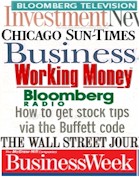The dangers of predicting future
performance were highlighted in a recent survey by Parson
Consulting, which found that only four of the top 100
ASX-listed companies met analyst earnings-per-share forecasts
last financial year.
As John Price, the developer
of the Conscious Investor share analysis software, says,
there is no point buying a bargain that stays a bargain.
Or worse, buying a bargain that turns out to be another
Enron.
"I say the only
question an investor needs to ask is what return do you
need to get. I don't put a value on shares in terms of
dollar value but in terms of returns," Price says.
After all, when you finally sell an investment, the important
thing is not what price you paid or whether it was overvalued
or undervalued at the time, but the total return of all
dividends received plus capital gains.
Controversially, Price [does
not] put much stress on dividends (see below).
"We talk about total returns,
dividend plus capital gains. Money is money," Price
says.
Buffett doesn't invest in a company unless he is confident
he can make at least a 10 per cent return.
Once you know what return you require and what margin
of error you can live with, Price says investors need
to sit back and look at the business behind the shares.
He says you can go a long way by asking a few questions;
the answers can be readily found on free websites.
Price says investors should
look for growth in earnings and sales, little or no debt
and strong and consistent growth in return on equity (ROE)
over the past five to 10 years. "If that hasn't been
happening, you have to ask why you think it will in the
future," Price says.
ROE is a key measure of profitability,
showing the profit made on ordinary share capital expressed
as a percentage. Buffett looks for a return of at least
12 or 13 per cent, preferably more. Much less and you
could invest for lower risk in other asset classes.
While these questions are numerical,
others are more subjective.
Buffett prefers businesses
he understands. Most Australians come into daily contact
with a range of retailers, goods and services, which gives
them an insight into how those businesses are going.
Price says to look at what distinguishes a company from
other businesses and whether it has an economic moat to
protect its cash flow. For an example of an economic moat,
investors need look no further than the Sydney Cross City
Tunnel, where the operators negotiated a contract closing
off alternative routes.
Also look at a company's competition,
brand name, and whether it is a market leader or has a
monopoly or patents on key technologies or products. Then
you should sit back and see if you can imagine the business
continuing successfully in future.
Price's valuation method does
take P/E ratios into account when deciding what price
to pay. He compares current and past P/E levels, information
that is available on some websites.
"If it's been 20 but is
now 15, this may be a good time to buy. Don't try to buy
on dips in price but on a dip in the P/E ratio,"
he says.
Even so, the better the business,
the less important the share price valuation becomes for
long-term investors.
"If you paid too much
for Westfield 20 years ago, so what? You would still be
a multi-millionaire today," Price says.
The drawbacks of
dividends
When the sharemarket is volatile
or the outlook uncertain, investors flock to companies
that pay solid dividends. Yet dividends can hide a multitude
of sins.
Price argues that shareholders
with a need for short-term cash could sell a few shares
and still end up better off in the long run than an investor
who buys a mediocre company for regular dividend income.
Warren Buffett's investment company, Berkshire Hathaway,
is a good example. It pays no dividends but shareholders
have been richly rewarded nonetheless.
Berkshire has produced a steady
return on equity of about 25 per cent a year and its shares
have grown by an annual average of 22 per cent over the
past 40 years.
This is a far better return
than most investors could achieve by receiving profits
as dividends and investing the money elsewhere.
[ Complete
article ]



